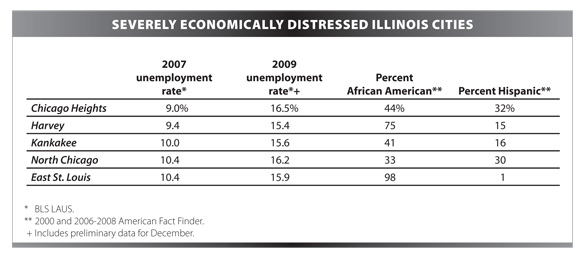Algernon Austin’s March 17, 1010 testimony on Chronic Unemployment, before the Congressional Black Caucus:
Good morning, Chairwoman Lee, Jobs Taskforce Chair Cleaver, and members of the Congressional Black Caucus. I am honored to speak with you today about “The Crisis of the Chronically Unemployed.”
In my very brief remarks, I will focus on the plight of African Americans in our cities. I will restrict my analysis to Illinois, but, unfortunately, I believe that major cities in many other states with large African-American populations would yield a similar picture.
To identify the populations that are chronically unemployed, it is useful to examine unemployment rates before the recession began. The first 11 months of 2007 was before the official start of the recession in December of that year. Thus, the annual 2007 unemployment rate presents mostly pre-recession data.
The national annual unemployment rate for 2007 was 4.6 percent. Several Illinois cities, however, had unemployment rates about twice the national rate in 2007. The 2007 annual unemployment rate for Chicago Heights was 9 percent. In Harvey the annual unemployment rate was 9.4 percent. In Kankakee, 10 percent. In North Chicago and East St. Louis, 10.4 percent. These cities were already experiencing economic conditions that look like a severe recession before the Great Recession began.

Demographically, these cities are all majority nonwhite. East St. Louis and Harvey are both majority black cities. The other cities are majority nonwhite when the African American and Hispanic populations are combined. Thus, it is the majority nonwhite cities in Illinois that seem to be most at-risk of suffering from chronic unemployment.
Although the city of Chicago, did not have an unemployment rate double the national rate in 2007, African Americans in the city did. My estimate of the unemployment rate for blacks in Chicago in 2007 is 17.7 percent. My estimate for whites is 4.5 percent. Thus, blacks in Chicago were nearly four times as likely as whites to be unemployed.
My message here is that the American economy does not work as well as it should for people of color and particularly for African Americans.
Some argue these disparities are due only to the lower educational attainment of blacks and to a spatial mismatch between where jobs are and where blacks live. But this view is not supported by the data. In Chicago, data from before the recession shows that at every education level blacks were more likely to be unemployed. In the three years before the recession, the unemployment rate for African Americans with bachelor’s degrees was 7.5 percent. This rate was closest to the rate for whites with only a high school diploma, 6.3 percent. The unemployment rate of 12.8 percent for blacks with some college education was most similar to the rate of 11.6 percent for white high school dropouts.
These data suggest that education alone cannot address the black-white unemployment disparity. More-educated blacks have unemployment rates comparable to less-educated whites. The data discussed here is restricted to the same geographic area—Chicago. Thus, geography or a spatial mismatch is of limited explanatory value since the whites and blacks are all living in the same city.
We need to do more to see that the economy works well for all Americans—including African Americans and other people of color. We need urban job-creation policies to revitalize cities suffering from chronic unemployment. We also need to re-double our efforts to ensure equal employment opportunities. We need to make information about job openings accessible to all workers and not only to those who are connected to current employees. We need to find ways to combat the continuing racial discrimination in the labor market. If we can do all of these things, we will have made a significant impact on chronic unemployment in America’s cities.